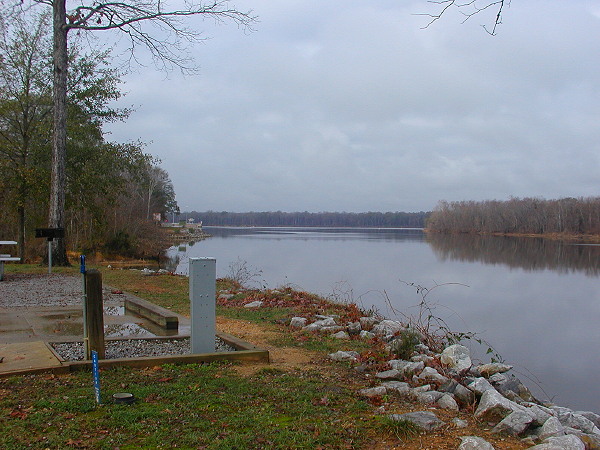Friday, December 21, 2007 - Foscue Creek Park, Demopolis AL
< previous day | archives | next day >
Let's get this winter solstice behind us
It's about 6:00 am here at Site 42 as I write this and I've been listening to the great blue herons honking in the dark for hours now. It would be nice if they had a little more light than the few street lights here at the park to see by.
What's in season?
Hunting season for some bird or animal requiring cannons must have opened here in Demopolis AL today. The dawn burst forth with considerable gunfire across the river from the campsite. Big guns. Shotguns I might think.
Site 51 is right on the river
My morning walk got me thinking as I walked out to the river it might be fun to rent Site 51 for a few days and sit here with my arse hanging out over the river barge spotting. LD's arse that is, with mine securely planted within on the sofa whilst I gaze out the big picture windows in the rear of this old 1992 Lazy Daze 26-1/2 MB (mid bath that is). That might be a hoot. I see from the hang tag on the post that Site 51 is reserved from today through the 28th so I might look into reserving it from the 28th through January 2, 2008 or so. Later: no go - site 51 is reserved right on through January 31, 2008 with the exception of a couple of days mid month. It looks like things will be picking up around after Christmas. Maybe it's time to move on.
Night camp
Site 42 - Foscue Creek Campground, Demopolis AL
- This is a well maintained US Army Corps of Engineers campground with level paved sites, most with full hookups
- Many sites overlook the water of the inlets off Demopolis Lake on the Tombigbee River
- There is good biking on the park roads
- The campground is pretty full Thanksgiving week and is generally booked solid the weekend of the Demopolis Christmas on the River festival in early December.
- Poor Verizon cell phone service - access is via Extended Network, roaming
- No Verizon EVDO service - access is via the Extended Network and service varies is slow but reliable
- Only 3 miles to Wal-Mart and other services in Demopolis AL
- Find other references to Foscue Creek
- List the nights I've camped here
- Check the weather
- Reserve a site
- Get a map
Finding the Words to Fit It
There is an idea current in the prevailing culture that writing about something that pains you heals the pain. I was not, when I began writing my life story, and am not now, healed of my mother. But you do gain a small distance from anything by keeping it in suspension in your mind while you work at finding the words to fit it. The process is so slow and incremental that you don't notice its effect, but the point is that it is a process.
Source: Almost There: the Onward Journey of a Dublin Woman, a Memoir by Nuala O'Faolain
